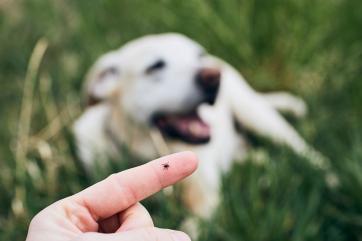Protecting Your Pet: Understanding and Preventing Lyme Disease In Alpena, Michigan

The approach to a pet’s overall health and wellness hinges on preventing a variety of illnesses. Without prevention, pets may be vulnerable to easily avoidable parasites, contagious diseases, unwanted litters, and even permanent loss or separation.
We still have many weeks of summer heat and humidity in front of us, and ticks are in full force here in Michigan. Preventing Lyme disease remains a high priority for responsible pet owners, and Switzer Veterinary Clinic is here to help.
The Reach and Impact of Lyme
Even if pets stay indoors, ticks can enter the home on human clothing, footwear, and gear. If they aren’t up to date on the parasite prevention medication, pets are vulnerable to tick-borne illness. Lyme disease is a zoonotic illness and can affect both humans and animals in the home.
Between the Lyme disease vaccine (appropriate for certain lifestyles) and/or monthly medication, pets are protected from tick-borne illness.
How Lyme Disease Spreads
Ticks transmit a bacteria called Borrelia burgdorferi directly into their host’s bloodstream after they latch onto the skin and bite. There are numerous types of ticks, but blacked-legged ticks or deer ticks, are the most prevalent in heavily wooded, grassy, or overgrown areas. They travel on their prey, falling off when they become engorged with blood. When hungry again, they lie in wait for new prey to walk by.
It can take up to a full day for a tick to transmit Borrelia burgdorferi, the bacteria that causes Lyme disease in animals and humans. The immediate removal of a tick is of critical importance.
What to Look For
Lyme disease in pets may not cause immediate or obvious signs. If symptoms do appear, they may range between mild and severe. Always look for the following signs and seek help immediately:
- Fever
- Lethargy
- Loss of appetite
- Lameness or limping
- Swollen lymph nodes
- Breathing problems
Diagnosis and Treatment
After a thorough examination, blood tests can detect the presence of antibodies against the Borrelia burgdorferi bacteria. Other imaging to understand the extent of joint inflammation or test to measure and analyze joint fluid may be needed to create a treatment plan that can include:
- A complete course of antibiotics
- Supportive treatments like intravenous fluids and/or pain medication.
For the best possible outcome, early detection and treatment is critical.
Empowering Pet Owners
Proactive measures can keep a pet safe from Lyme disease:
- Whether it’s a topical treatment of an oral medication, we can help you decide on the best tick product.
- A pet’s lifestyle (lots of regular hiking or outdoor adventures) may warrant the Lymne disease vaccine. The vaccine can thwart infection, and possibly reduce the severity of Lyme disease if a pet does become infected.
- Regular skin and coat checks can reduce the impact of ticks. Pay close attention to the feet, neck, chest, ears, and tail.
- Take time to remove tick habitat around your property. Remove leaf litter, wood piles, and keep shrubs trimmed. A barrier of wood chips or gravel can deter tick travel.
Our staff at Switzer Veterinary Clinic is always here to help your pet. Please call us at (989) 356‑4880 with any questions or concerns.

